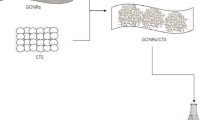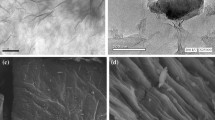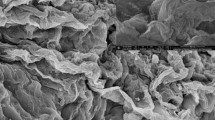Abstract
A novel adsorbent of magnetic graphene oxide/chitosan (MGOC) composite has been prepared via chemical cross-linking method, and exhibits an extraordinary sorption capacity (about 59.82 mg/g) towards cobalt ions. The batch experiments revealed that MGOC is weakly affected by ionic strength and pH-dependent for cobalt ions sorption. The sorption process is spontaneous and endothermic according to thermodynamic parameters, following the pseudo-second-order model. In view of low price, high adsorption capacity, great saturation magnetization and perfect reusability, the MGOC composite maybe has a potential value in treatment of radiocobalt-containing wastewater.











Similar content being viewed by others
References
Lee XJ, Hiew BYZ, Lai KC, Lee LY, Gan S, Thangalazhy-Gopakumar S, Rigby S (2019) Review on graphene and its derivatives: synthesis methods and potential industrial implementation. J Taiwan Inst Chem Eng 98:163–180
Zhu Y, Murali S, Cai W, Li X, Suk JW, Potts JR, Ruoff RS (2010) Graphene and graphene oxide: synthesis, properties, and applications. Adv Mater 22(35):3906–3924
Kuila T, Bose S, Mishra AK, Khanra P, Kim NH, Lee JH (2012) Chemical functionalization of graphene and its applications. Prog Mater Sci 57(7):1061–1105
Smith SC, Rodrigues DF (2015) Carbon-based nanomaterials for removal of chemical and biological contaminants from water: a review of mechanisms and applications. Carbon 91:122–143
Weng X, Wu J, Ma L, Owens G, Chen Z (2019) Impact of synthesis conditions on Pb(II) removal efficiency from aqueous solution by green tea extract reduced graphene oxide. Chem Eng J 359:976–981
Fu W, Huang Z (2018) Magnetic dithiocarbamate functionalized reduced graphene oxide for the removal of Cu(II), Cd(II), Pb(II), and Hg(II) ions from aqueous solution: synthesis, adsorption, and regeneration. Chemosphere 209:449–456
Kuzenkova AS, Romanchuk AY, Trigub AL, Maslakov KI, Egorov AV, Amidani L, Kittrell C, Kvashnina KO, Tour JM, Talyzin AV, Kalmykov SN (2020) New insights into the mechanism of graphene oxide and radionuclide interaction. Carbon 158:291–302
Georgakilas V, Tiwari JN, Kemp KC, Perman JA, Bourlinos AB, Kim KS, Zboril R (2016) Noncovalent functionalization of graphene and graphene oxide for energy materials, biosensing, catalytic, and biomedical applications. Chem Rev 116(9):5464–5519
Majumder S, Sardar M, Satpati B, Kumar S, Banerjee S (2018) Magnetization enhancement of Fe3O4 by attaching onto graphene oxide: an interfacial effect. J Phys Chem C 122(37):21356–21365
Choi D-w, Park H, Lim JH, Han TH, Park J-S (2017) Three-dimensionally stacked Al2O3/graphene oxide for gas barrier applications. Carbon 125:464–471
Khan SA, Arshad Z, Shahid S, Arshad I, Rizwan K, Sher M, Fatima U (2019) Synthesis of TiO2/Graphene oxide nanocomposites for their enhanced photocatalytic activity against methylene blue dye and ciprofloxacin. Compos B Eng 175:107120
Ain QU, Farooq MU, Jalees MI (2020) Application of magnetic graphene oxide for water purification: heavy metals removal and disinfection. J Water Process Eng 33:101044
Liu Y, Huang H, Gan D, Guo L, Liu M, Chen J, Deng F, Zhou N, Zhang X, Wei Y (2018) A facile strategy for preparation of magnetic graphene oxide composites and their potential for environmental adsorption. Ceram Int 44(15):18571–18577
Lujanienė G, Šemčuk S, Lečinskytė A, Kulakauskaitė I, Mažeika K, Valiulis D, Pakštas V, Skapas M, Tumėnas S (2017) Magnetic graphene oxide based nano-composites for removal of radionuclides and metals from contaminated solutions. J Environ Radioact 166:166–174
Li Q, Fan F, Wang Y, Feng W, Ji P (2013) Enzyme immobilization on carboxyl-functionalized graphene oxide for catalysis in organic solvent. Ind Eng Chem Res 52(19):6343–6348
Perreault F, Fonseca de Faria A, Elimelech M (2015) Environmental applications of graphene-based nanomaterials. Chem Soc Rev 44(16):5861–5896
Padala AN, Bhaskarapillai A, Velmurugan S, Narasimhan SV (2011) Sorption behaviour of Co(II) and Cu(II) on chitosan in presence of nitrilotriacetic acid. J Hazard Mater 191(1):110–117
Liu L, Li C, Bao C, Jia Q, Xiao P, Liu X, Zhang Q (2012) Preparation and characterization of chitosan/graphene oxide composites for the adsorption of Au(III) and Pd(II). Talanta 93:350–357
Izah SC, Chakrabarty N, Srivastav AL (2016) A review on heavy metal concentration in potable water sources in Nigeria: human health effects and mitigating measures. Expo Health 8(2):285–304
Zhao X, Luo Y, He C, Zong P, Zhang K, Kebwaro JM, Li K, Fu B, Zhao Y (2015) Evaluation of permutite for removal of radiocobalt from nuclear wastewater. J Radioanal Nucl Chem 303(1):837–844
Hummers WS, Offeman RE (1958) Preparation of graphitic oxide. J Am Chem Soc 80(6):1339–1339
Liang Y, Zhang L (2007) Bioconjugation of papain on superparamagnetic nanoparticles decorated with carboxymethylated chitosan. Biomacromol 8(5):1480–1486
Solomons TWG (1980) Organic chemical. Wiley, New York
Tirkistani FAA (1998) Thermal analysis of some chitosan Schiff bases. Polym Degrad Stab 60(1):67–70
Magalhães JMCS, Machado AASC (1998) Urea potentiometric biosensor based on urease immobilized on chitosan membranes. Talanta 47(1):183–191
Ai L, Zhang C, Chen Z (2011) Removal of methylene blue from aqueous solution by a solvothermal-synthesized graphene/magnetite composite. J Hazard Mater 192(3):1515–1524
El Ghandoor H, Zidan HM, Khalil MMH, Ismail MIM (2012) Synthesis and some physical properties of magnetite (Fe3O4) nanoparticles. Int J Electrochem Sci 7(6):5734–5745
Lagergren S (1898) About the theory of so-called adsorption of solution substances. Handlinger 24:1–39
Ho YS (2006) Review of second-order models for adsorption systems. J Hazard Mater 136(3):681–689
Şenol ZM, Gürsoy N, Şimşek S, Özer A, Karakuş N (2020) Removal of food dyes from aqueous solution by chitosan-vermiculite beads. Int J Biol Macromol 148:635–646
Li K, Hu J, Liu Z, Chen L, Dong Y (2013) Sorption of radiocobalt(II) onto MWCNTs: effects of solid content, contact time, pH, ionic strength, humic acid and temperature. J Radioanal Nucl Chem 295(3):2125–2133
Ding J, Sha H, Zhao S, Liu X (2016) Synthesis of graphene oxide/magnetite chitosan composite and adsorption performance for sulfadiazine. Acta Sci Circum 36(10):3691–3700
Yüzer H, Kara M, Sabah E, Çelik MS (2008) Contribution of cobalt ion precipitation to adsorption in ion exchange dominant systems. J Hazard Mater 151(1):33–37
Wang H, Zhang P, Ma X, Jiang S, Huang Y, Zhai L, Jiang S (2014) Preparation, characterization of electrospun meso-hydroxylapatite nanofibers and their sorptions on Co(II). J Hazard Mater 265:158–165
Langmuir I (1916) The constitution and fundamental properties of solids and liquids part I solids. J Am Chem Soc 38(11):2221–2295
Langmuir I (1918) The adsorption of gases on plane surfaces of glass, micra and platinum. J Am Chem Soc 40(9):1361–1403
Nassar MM, Ewida KT, Ebrahiem EE, Magdy YH, Mheaedi MH (2004) Adsorption of iron and manganese ions using low-cost materials as adsorbents. Adsorpt Sci Technol 22(1):25–37
Şimşek S, Şenol ZM, Ulusoy Hİ (2017) Synthesis and characterization of a composite polymeric material including chelating agent for adsorption of uranyl ions. J Hazard Mater 338:437–446
Yang S, Li J, Shao D, Hu J, Wang X (2009) Adsorption of Ni(II) on oxidized multi-walled carbon nanotubes: effect of contact time, pH, foreign ions and PAA. J Hazard Mater 166(1):109–116
Tahir SS, Rauf N (2003) Thermodynamic studies of Ni(II) adsorption onto bentonite from aqueous solution. J Chem Thermodyn 35(12):2003–2009
Qadeer R, Hanif J, Saleem M, Afzal M (1993) Surface characterization and thermodynamics of adsorption of Sr2+, Ce3+, Sm3+, Gd3+, Th4+, UO22+on activated charcoal from aqueous solution. Colloid Polym Sci 271(1):83–90
Zhuang ST, Yin YN, Wang JL (2018) Simultaneous detection and removal of cobalt ions from aqueous solution by modified chitosan beads. Int J Environ Sci Technol 15(2):385–394
Omar H, Arida H, Daifullah A (2009) Adsorption of 60Co radionuclides from aqueous solution by raw and modified bentonite. Appl Clay Sci 44(1):21–26
Tayyebi A, Outokesh M, Moradi S, Doram A (2015) Synthesis and characterization of ultrasound assisted “graphene oxide–magnetite” hybrid, and investigation of its adsorption properties for Sr(II) and Co(II) ions. Appl Surf Sci 353:350–362
Wang X, Liu Y, Pang H, Yu S, Ai Y, Ma X, Song G, Hayat T, Alsaedi A, Wang X (2018) Effect of graphene oxide surface modification on the elimination of Co(II) from aqueous solutions. Chem Eng J 344:380–390
Fang F, Kong L, Huang J, Wu S, Zhang K, Wang X, Sun B, Jin Z, Wang J, Huang X-J, Liu J (2014) Removal of cobalt ions from aqueous solution by an amination graphene oxide nanocomposite. J Hazard Mater 270:1–10
Deng J, Zhao Y, Tong D, Yang L (2019) Synthesis of magnetic graphene oxide for removal of Co(II)from aqueous solution. J Nucl Radiochem 41(3):283–289
Zhao Y, Zhao X, Deng J, He C (2016) Utilization of chitosan–clinoptilolite composite for the removal of radiocobalt from aqueous solution: kinetics and thermodynamics. J Radioanal Nucl Chem 308(2):701–709
Acknowledgements
We thank the financial supports by National Natural Science Foundation of China (Grant Nos. 11775168 and 11275147) and Innovative Scientific Program of CNNC.
Author information
Authors and Affiliations
Corresponding authors
Additional information
Publisher's Note
Springer Nature remains neutral with regard to jurisdictional claims in published maps and institutional affiliations.
Rights and permissions
About this article
Cite this article
Ouyang, Y., Deng, J., Chen, Z. et al. Preparation and assessment of magnetic graphene oxide/chitosan composite for removing radiocobalt from aqueous solution. J Radioanal Nucl Chem 326, 1699–1708 (2020). https://doi.org/10.1007/s10967-020-07462-5
Received:
Accepted:
Published:
Issue Date:
DOI: https://doi.org/10.1007/s10967-020-07462-5




